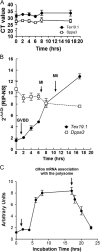Acquisition of oocyte competence to develop as an embryo: integrated nuclear and cytoplasmic events
- PMID: 29432538
- PMCID: PMC5907346
- DOI: 10.1093/humupd/dmx040
Acquisition of oocyte competence to develop as an embryo: integrated nuclear and cytoplasmic events
Abstract
Infertility affects ~7% of couples of reproductive age with little change in incidence in the last two decades. ART, as well as other interventions, have made major strides in correcting this condition. However, and in spite of advancements in the field, the age of the female partner remains a main factor for a successful outcome. A better understanding of the final stages of gamete maturation yielding an egg that can sustain embryo development and a pregnancy to term remains a major area for improvement in the field. This review will summarize the major cellular and molecular events unfolding at the oocyte-to-embryo transition. We will provide an update on the most important processes/pathways currently understood as the basis of developmental competence, including the molecular processes involved in mRNA storage, its recruitment to the translational machinery, and its degradation. We will discuss the hypothesis that the translational programme of maternal mRNAs plays a key role in establishing developmental competence. These regulations are essential to assemble the machinery that is used to establish a totipotent zygote. This hypothesis further supports the view that embryogenesis begins during oogenesis. A better understanding of the events required for developmental competence will guide the development of novel strategies to monitor and improve the success rate of IVF. Using this information, it will be possible to develop new biomarkers that may be used to better predict oocyte quality and in selection of the best egg for IVF.
Figures




References
-
- Ali A, Sirard MA. Protein kinases influence bovine oocyte competence during short-term treatment with recombinant human follicle stimulating hormone. Reproduction 2005;130:303–310. - PubMed
-
- Almonacid M, Ahmed WW, Bussonnier M, Mailly P, Betz T, Voituriez R, Gov NS, Verlhac MH. Active diffusion positions the nucleus in mouse oocytes. Nat Cell Biol 2015;17:470–479. - PubMed
-
- Araki K, Naito K, Haraguchi S, Suzuki R, Yokoyama M, Inoue M, Aizawa S, Toyoda Y, Sato E. Meiotic abnormalities of c-mos knockout mouse oocytes: activation after first meiosis or entrance into third meiotic metaphase. Biol Reprod 1996;55:1315–1324. - PubMed

